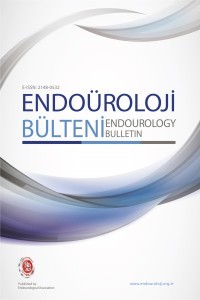Nörovasküler Bundle Koruyucu Robot Yardımlı Radikal Prostatektomide Klipsiz ve Atermal Pedikül Kontrolü Sağlayan Selektif Sütürasyon Tekniği
Prostat Kanseri, Robotik Cerrahi, Klipsiz
Clipless and Athermal Pedicle Control with Selective Suturing Technique Proceeding with Neurovascular Bundle Preservation during Robot Assisted Radical Prostatectomy
Robotic surgery, prostate cancer, clipless,
___
- 1. Walsh PC and Donker PJ: Impotence following radical prostatectomy: Insight into etiology and prevention. J Urol 128: 492– 497, 1982.
- 2. Palou J, Alberola JM, Villavicencio H, Vicente J. It’s like a pain in the perineum: a surgical clip protruding into the urethra through the urethrovesical anastomosis after radical prostatectomy. Scand J Urol Nephrol 1997;31:493-5.
- 3. Long B, Bou S, Bruyere F, Lanson Y. Vesicourethral anastomotic stricture after radical prostatectomy secondary to migration of a metal clip. Prog Urol 2006;16:384-5.
- 4. Banks EB, Ramani A, Monga M. Intravesical Weck clip migration after laparoscopic radical prostatectomy. Urology 2008;71:351.
- 5. Kadekawa K, Hossain RZ, Nishijima S, Miyazato M, Hokama S, Oshiro Y, et al. Migration of a metal clip into the urinary bladder. Urol Res 2009;37:117-9.
- 6. Tunnard GJ, Biyani CS. An unusual complication of a Hem-o-Lok clip following laparoscopic radical prostatectomy. J Laparoendosc Adv Surg Tech A 2009;19:649-51.
- 7. Mora ER, Gali OB, Garin JA, Arango O. Intravesical migration and spontaneous expulsion of a Hem-o-lok polymer ligating clip after laparoscopic radical prostatectomy. Urology 2010;75:1317.
- 8. Ong AM, Us LM, Varkarakis I, et al. Nerve sparing radical prostatectomy: Effects of hemostatic energy sources on the recovery of cavernous nerve function in a canine model. J Urol 2004;172:1318– 1322.
- 9. Menon M, Tewari A, Peabody J; VIP Team. Vattikuti Institute prostatectomy: Technique. J Urol 2003;169:2289– 2292.
- 10. Mora ER, Gali OB, Garin JA, Arango O. Intravesical migration and spontaneous expulsion of a Hem-o-lok polymer ligating clip after laparoscopic radical prostatectomy. Urology 2010;75:1317.
- 11. Yi JS, Kwak C, Kim HH, Ku JH: Surgical clip-related complications after radical prostatectomy. Korean J Urol. 2010, 51 (10): 683-687.
- 12. Banks EB, Ramani A, Monga M. Intravesical Weck clip migration after laparoscopic radical prostatectomy. Urology 2008;71:351.
- 13. Mora ER, Gali OB, Garin JA, Arango O. Intravesical migration and spontaneous expulsion of a Hem-o-lok polymer ligating clip after laparoscopic radical prostatectomy. Urology 2010;75:1317.
- 14. Borboroglu PG, Sands JP, Roberts JL, Amling CL. Risk factors for vesicourethral anastomotic stricture after radical prostatectomy. Urology 2000;56:96-100.
- 15. Blumenthal KB, Sutherland DE, Wagner KR, Frazier HA, Engel JD. Bladder neck contractures related to the use of Hem-o-Lok clips in robot-assisted laparoscopic radical prostatectomy. Urology 2008;72:158-61.
- 16. Cormio L, Massenio P, Lucarelli G, et al. Hem-o-lok clip: a neglected cause of severe bladder neck contracture and consequent urinary incontinence after robot-assisted laparoscopic radical prostatectomy. BMC Urol 2014;14:21.
- 17. Ahlering TE, Eichel L, and Skarecky DW: Early potency with cautery free neurovascular bundle preservation study in robotic laparoscopic radical prostatectomy. J Endourol 19: 715-718, 2005.
- 18. Gill IS, Ukimura O, Rubinstein M, et al: Lateral pedicle control during laparoscopic radical prostatectomy: refined technique. Urology 65: 23-27, 2005.
- Yayın Aralığı: Yılda 3 Sayı
- Başlangıç: 2020
- Yayıncı: ENDOÜROLOJİ DERNEĞİ
Robot Yardımlı Laparoskopik Retroperitoneal Parsiyel Nefrektomi
Mahmut Taha ÖLÇÜCÜ, Kayhan YILMAZ, Mutlu ATEŞ
Bir Bakışta Üriner Sistem Taş Hastalığına Metabolik Yaklaşım
T1a/T1b Evre Renal Tümörlerde Laparoskopik Parsiyel Nefrektomi: Biz Neredeyiz?
Mehmet Salih BOĞA, Murat SAVAŞ, Mahmut Ekrem İSLAMOĞLU, Mehmet Giray SÖNMEZ, Kayhan YILMAZ, Mahmut Taha ÖLÇÜCÜ, Kaan KIRAMIK, Çağatay ÖZSOY, Mutlu ATEŞ
Yazılım Destekli Manyetik Rezonans Ultrason Füzyon Biyopsi Tekniklerine Güncel Bakış
Selahattin BEDİR, Engin KAYA, Serdar YALÇIN, Murat ZOR
Mustafa BOZ, Vahit GÜZELBURÇ, Gökhan ÇALIK, Mustafa SOYTAŞ, Çağrı KAÇTAN, Selçuk GÜVEN
Supin Perkütan Nefrolitotomi-Eski Köye Yeni Adet
Prostat Enükleasyonunda Lazer Savaşları : Holmium vs Thulium Lazer
Mehmet YILMAZ, Engin KAYA, Eymen GAZEL, Serdar YALÇIN, Sercan YILMAZ, Halil Çağrı AYBAL, Lütfi TUNÇ
Mesane Tümörünü Taklit Eden İntravesikal Yabancı Cisim: Nadir Bir Olgu Sunumu
Engin KAYA, Nejdet KARŞIYAKALI, Selçuk SARIKAYA, Sinan AKAY, Turgay EBİLOĞLU, Murat ZOR, Selahattin BEDİR
